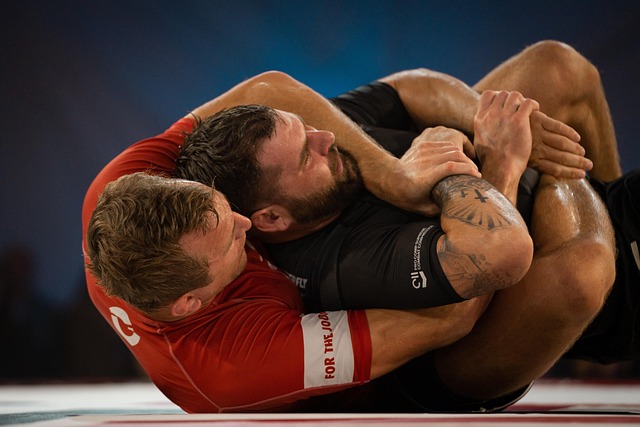
https://pixabay.com/photos/bjj-jiu-jitsu-jiu-jitsu-jiujitsu-8111387/
In this article, we will look at the main components of training for Mixed Martial Arts (MMA) athletes. From sparring and bag work, to strength and conditioning and post-training recovery, we will examine the basics of MMA training. So read on for some tips on how to train like a pro!
Sparring
They say iron sharpens iron. Live, contact sparring is one of the main differentiators between traditional martials arts which became useful as a part of MMA, and the purely theoretical arts focused on forms/kata and without sparring with a resisting opponent. For example, striking arts such as Muay Thai, boxing, and kickboxing all emphasize contact sparring. Similarly, grappling based arts like wrestling, judo, and Brazilian Jiu-Jitsu (BJJ) are focused on ‘rolling’ or grappling with a resisting opponent. Simulating live contact competition in practice is the reason why arts like Sambo work so well in MMA — and ones like Kung Fu do not.
Strength & Conditioning
In layman’s terms, strength and conditioning is what most people think of when they say ‘exercise’. This includes any strenuous activity intended to build strength and/or endurance. Weightlifting, cardio workouts such as running or swimming, and body weight exercises all fall under this category. MMA is a highly physical sport, with strength and endurance being very necessary pre-requisites. Whether it’s lifting heavy weights, pushing a tire uphill, or doing high-intensity interval training, strength & conditioning is paramount to preparing for an MMA bout. Some fighters like Tony Ferguson and Merab Dvalishvili have enlisted help of celebrity S&C specialists like David Goggins to mentor them in this aspect.
Post-Training Recovery
Recovery is an often overlooked, but extremely important part of training. There’s nothing quite as relaxing as a full body massage after an intense workout or sparring session. Other recovery methods includes saunas and steam rooms, ice baths, stretching, and yoga. One has to let their muscles recover and rebuild after exercise, to achieve maximum gains.
Bag Work
While S&C and recovery are significant for almost all sports, and sparring is a component of both grappling and striking arts, this next aspect of MMA training is unique to striking sports – boxing, kickboxing, Muay Thai all empathize practicing your blows on a bag of some sort. There are the traditional heavy bags, speed bags, even special bags designed to lay on the ground for simulating ground-and-pound techniques.
Technique Drills
We earlier mentioned the importance of live, contact sparring, as opposed to kata and forms. This is not to says that the latter have no place in effective MMA training, in their most basic form. Drilling techniques can be done without an opponent, or with one who is not resisting, to allow you to practice your moves. This includes things like mitt work with a coach. As Bruce Lee once said, “I fear not the man who has practiced 10,000 kicks once, but I fear the man who has practiced one kick 10,000 times.”
Conclusion
MMA is a complex sport with many different components. When training for such a sport, one needs to focus on all the different aspects of it. This includes training in striking, wrestling, and submissions; as well as strength & conditioning, bag work, drilling techniques, and post-workout recovery. You must become a very well-rounded athlete to succeed in the ring or Octagon, and that just cannot be accomplished without dedicating yourself to training.


